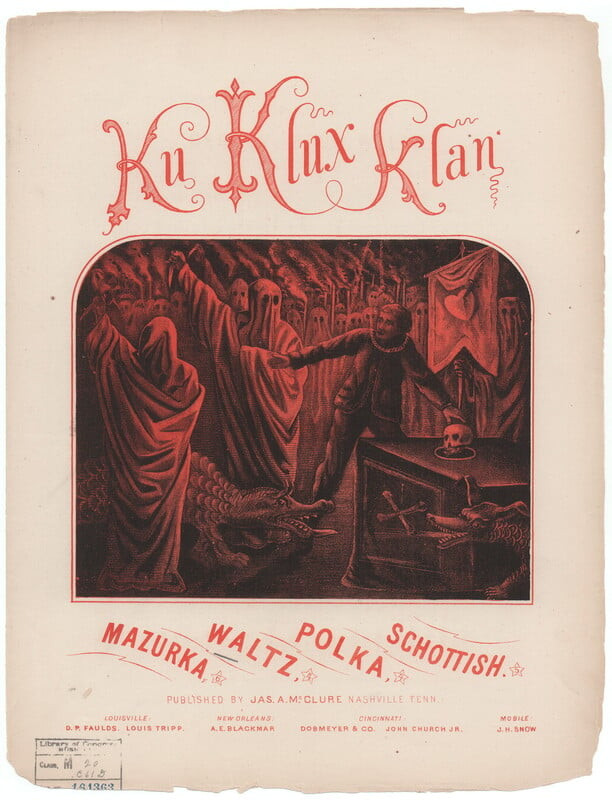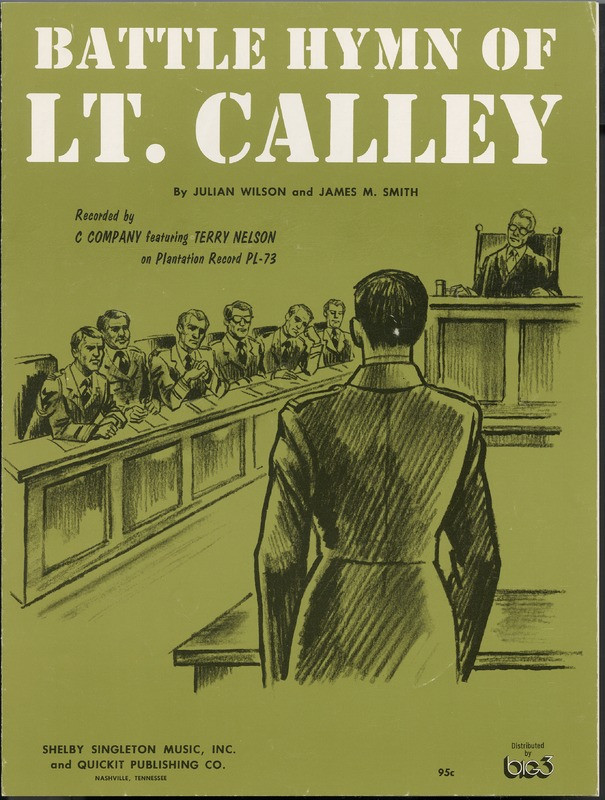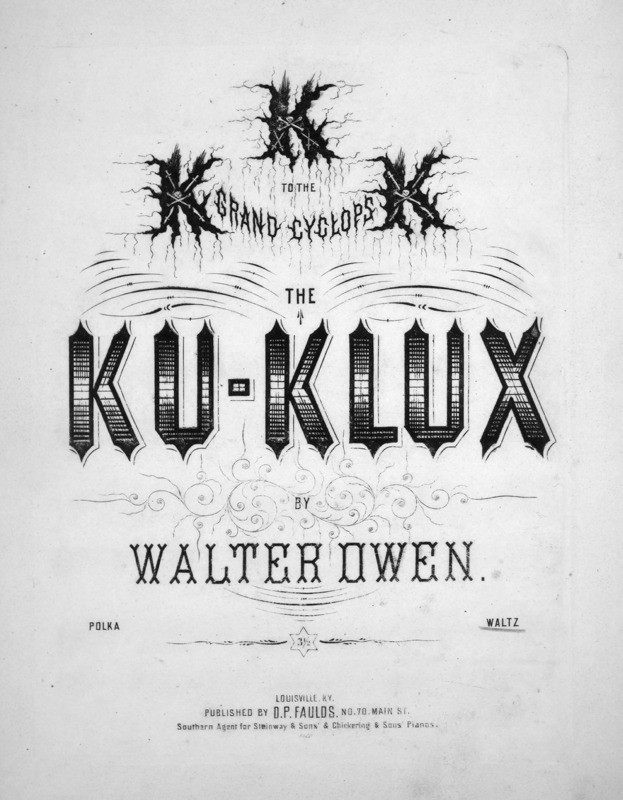Music served as a powerful and multifaceted tool for the Ku Klux Klan throughout its history. From recruitment drives and social gatherings to propaganda dissemination and ceremonial events, songs played a crucial role in Klan activities. This exploration delves into the disturbing world of Ku Klux Klan Songs, examining their themes and purposes, largely drawing from Danny Crew’s comprehensive work, “Ku Klux Klan Sheet Music- An Illustrated Catalogue of Published Music.”
Content warning: This article contains uncensored racist language that may be offensive. Reader discretion is advised.
Bloody Moon Waltz (Courtesy Library of Congress)
The Myth of Biological Superiority in Klan Music
While the racist ideology of white supremacy was often subtly hinted at through minstrel shows portraying Black individuals as caricatures, Ku Klux Klan songs made these hateful beliefs explicit. These songs promoted the dangerous notion of white biological superiority. One example, “Mystic City,” boldly proclaims in its chorus, “To God and Old Glory we bend the knee, sublime lineage written in history sands.” This concept of a ‘sublime lineage’ or a uniquely superior white ancestry remains a cornerstone of white supremacist thought even today. Modern white supremacists frequently fabricate connections to Norse gods like Odin and Thor to bolster their claims of racial superiority. Further examples from Klan sheet music highlight this obsession with racial purity and lineage:
Junior Boys Klan Chorus lyrics clearly demonstrate this exclusionary ideology:
Verse 3: “Were you born across the water? Then a member you can’t be.”
Chorus: “We are natives, we were born this side of the sea. We will never intermarry– America is our home.”
My Black Faced Fellow reinforces the hateful doctrine of racial separation:
“No, you can not mix with the whites so far, for a blue eyed nigger don’t look here. But for white supremacy, we surely stand, from the least to the greatest in the Ku Klux Klan.”
White Genocide and Cultural Loss: Fears Amplified in Song
Closely linked to the false premise of biological superiority is the white supremacist fear of ‘white genocide’ and the erosion of ‘white culture’ through interracial relationships and immigration. Ku Klux Klan songs frequently exploited these anxieties to incite fear and hatred.
The Wreckers uses allegorical imagery to portray a nation under threat from outsiders:
Verse 1: “Look Miss Liberty is weeping, my it seems her proud heart breaks. Is the nation’s flag in peril, ye the statute [sic] even shakes. Working was a mob of wreckers they of many tongues and race, were a gnawing at its vitals, were a striking at its base.”
Verse 3 continues this theme, suggesting betrayal from within: “Some among that mob of wreckers were her sons of rank and birth, mixing, mingling with the wreckers, born on other parts of earth. And this mob of fiendish wrekers, not for reasons of their need, they would crucify their freedoms just to satisfy their greed.”
Mystic City further articulates this fear of cultural displacement:
“In this dream he saw old Glory and the cause of liberty being surplanted [sic] by a people who had come across the sea, bringing with them flags and customs belong to primeval man, to affix and plant them firmly in this, our native land.”
Recruitment and Ritual: Music as a Tool for Klan Expansion
Ku Klux Klan recruitment songs often toned down the overtly violent and hateful rhetoric to appeal to a broader audience. Instead, these songs focused on themes of patriotism, brotherhood, loyalty, and shared identity. The lyrics often evoked a sense of belonging and purpose, using language that could easily be adapted for other fraternal or patriotic organizations.
Come Join the Knights of the Ku Klux Klan exemplifies this recruitment strategy:
Chorus: “Be a man if you are a real American, if you love to see old glory wave join this band of the free and the brave.”
The Call of a Klansman directly appeals to potential members based on shared values:
Verse 2: “If you believe in righteous liberties and the brotherhood of man, then we want you for a klansman, won’t you come and join our klan?”
Beyond recruitment, music also played a role in Klan ceremonies, fostering a sense of community and shared purpose among members. A ‘closing ceremony’ ritual lyric emphasizes this fraternal bond: “Blest be the Klansman’s tie of real fraternal love, that binds us in a fellowship akin to that above.”
Religious Prejudice: Antisemitism and Anti-Catholicism in Klan Songs
Religious bigotry, particularly antisemitism and anti-Catholicism, was a prominent theme in Ku Klux Klan songs. These songs propagated harmful stereotypes and warned against perceived threats from Jewish and Catholic communities. One song chillingly warns Jewish people: “O Jew, O Jew, my huckleberry Jew– be careful what you do, do. The tide may turn most any time and leave you in a stew, too. So keep your tongue and hold your peace the very best you can. For somethings [sic] coming up the road that looks like the Ku Klux Klan.”
The Cross in the Wildwood reveals the Klan’s anti-Catholic sentiment:
Verse 2: “Each klansman has sworn to be true. He has pledged to uphold Old Glory, not to down the catholic and the jew.” (Note: The lyric ironically states not to down Catholic and Jewish people, but in the context of Klan ideology, this likely carries a sinister double meaning, subtly threatening these groups while appearing to pledge tolerance to outsiders.)
Repurposing Familiar Tunes: Exploiting Patriotism
A common tactic employed by the Ku Klux Klan was setting their lyrics to well-known patriotic melodies and hymns. Tunes like “Yankee Doodle,” “Auld Lang Syne,” “Battle Hymn of the Republic,” and “Maryland, My Maryland” were repurposed to carry Klan messages, leveraging pre-existing positive emotional associations with these songs. “Battle Hymn of the Republic” (also known as “Glory Hallelujah”) has been repeatedly adapted for various purposes, including, disturbingly, a song defending Lieutenant Calley, who was involved in the My Lai Massacre during the Vietnam War.
Battle Hymn of Lt. Calley
By using familiar and patriotic tunes, Klan songwriters could instantly evoke feelings of patriotism and nostalgia in their audiences, making their hateful messages more palatable and emotionally resonant. Listening to “Battle Hymn for Lieutenant Calley,” we can hear how the militaristic snare drum and banjo create a sense of rural Americana and patriotic fervor even before the lyrics begin. This demonstrates how familiar tunes could be exploited to normalize or even glorify reprehensible actions.
Ku Klux Waltz
The “Ku Klux Waltz,” dedicated “To the Grand Cyclops” in a menacing font, was composed by Walter Owen and published as both a polka and waltz in Louisville, Kentucky, in 1868. This timing places it within the era of the first iteration of the Ku Klux Klan, largely composed of Confederate veterans. The instrumental nature of this dance piece suggests its use in Klan social gatherings. The waltz’s elaborate composition, reminiscent of Johann Strauss II, reveals a disturbing contrast: a beautiful melody masking the underlying hatred and racism of the organization it represented.
Conclusion: The Sinister Harmony of Hate
Ku Klux Klan songs offer a chilling glimpse into the ideology and tactics of this hate group. Through analyzing their lyrics and musical choices, we can understand how music was strategically employed to promote white supremacy, incite fear, recruit members, and build a sense of community based on exclusion and hatred. These songs serve as a stark reminder of the insidious power of propaganda and the importance of critically examining the messages embedded within music and culture.




